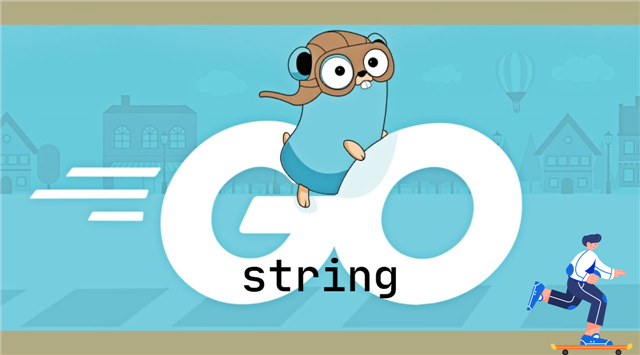标签:了解 intro www 拼接 十进制 怎么 use stand str

字符串(string) 作为 go 语言的基本数据类型,在开发中必不可少,我们务必深入学习一下,做到一清二楚。
本文假设读者已经知道切片(slice)的使用,如不了解,可阅读 Go 切片 基本知识点
为了更好的理解后文,推荐先阅读 Unicode 字符集,UTF-8 编码
In Go, a string is in effect a read-only slice of bytes.
在 go 语言中,字符串实际上是一个只读的字节切片,其数据结构定义如下:
// runtime/string.go
type stringStruct struct {
str unsafe.Pointer // 指向底层字节数组的指针
len int // 字节数组的长度
}
注意:byte 其实是 uint8 的类型别名
// byte is an alias for uint8 and is equivalent to uint8 in all ways. It is
// used, by convention, to distinguish byte values from 8-bit unsigned
// integer values.
type byte = uint8
func main() {
// 使用字符串字面量初始化
var a = "hi,狗"
fmt.Println(a)
// 可以使用下标访问,但不可修改
fmt.Printf("a[0] is %d\n", a[0])
fmt.Printf("a[0:2] is %s\n", a[0:2])
// a[0] = ‘a‘ 编译报错,Cannot assign to a[0]
// 字符串拼接
var b = a + "狗"
fmt.Printf("b is %s\n", b)
// 使用内置 len() 函数获取其长度
fmt.Printf("a‘s length is: %d\n", len(a))
// 使用 for;len 遍历
for i := 0; i < len(a); i++ {
fmt.Println(i, a[i])
}
// 使用 for;range 遍历
for i, v := range a {
fmt.Println(i, v)
}
}
/* output
hi,狗
a[0] is 104
a[0:2] is hi
b is hi,狗狗
a‘s length is: 6
0 104
1 105
2 44
3 231
4 139
5 151
0 104
1 105
2 44
3 29399
*/
如果读者在看上面的代码时有疑惑,不用着急,下文将会挨个解读。
字符串常量会在编译期分配到只读段,对应数据地址不可写入,相同的字符串常量不会重复存储
func main() {
var a = "hello"
fmt.Println(a, &a, (*reflect.StringHeader)(unsafe.Pointer(&a)))
a = "world"
fmt.Println(a, &a, (*reflect.StringHeader)(unsafe.Pointer(&a)))
var b = "hello"
fmt.Println(b, &b, (*reflect.StringHeader)(unsafe.Pointer(&b)))
}
/* output
字符串字面量 该变量的内存地址 底层字节切片
hello 0xc0000381f0 &{5033779 5}
world 0xc0000381f0 &{5033844 5}
hello 0xc000038220 &{5033779 5}
*/
可以看到 hello 在底层只存储了一份
go 的源代码都是 UTF-8 编码格式的,上例中的”狗“字占用三个字节,即 231 139 151(Unicode Character Table),所以上例的运行结果很清楚。
于此同时,也可以将字符串转化为字节切片
func main() {
var a = "hi,狗"
b := []byte(a)
fmt.Println(b) // [104 105 44 231 139 151]
}
The Unicode standard uses the term "code point" to refer to the item represented by a single value.
在 Unicode 标准中,使用术语 code point 来表示由单个值表示的项,通俗点来说,U+72D7(十进制表示为 29399)代表符号 ”狗“
"Code point" is a bit of a mouthful, so Go introduces a shorter term for the concept: rune.
code point 有点拗口,所以在 go 语言中专门有一个术语来代表它,即 rune
注意:rune 其实是 int32 的类型别名
// rune is an alias for int32 and is equivalent to int32 in all ways. It is
// used, by convention, to distinguish character values from integer values.
type rune = int32
在对字符串类型进行 for;range 遍历时,其实是按照 rune 类型来解码的,所以上例的运行结果也很清晰。
与此同时,也可以将字符串转化为 rune 切片
func main() {
// 使用字符串字面量初始化
var a = "hi,狗"
r := []rune(a)
fmt.Println(r) // [104 105 44 29399]
}
当然我们也可以使用 "unicode/utf8" 标准库,手动实现 for;range 语法糖相同的效果
func main() {
var a = "hi,狗"
for i, w := 0, 0; i < len(a); i += w {
runeValue, width := utf8.DecodeRuneInString(a[i:])
fmt.Printf("%#U starts at byte position %d\n", runeValue, i)
w = width
}
}
/* output
U+0068 ‘h‘ starts at byte position 0
U+0069 ‘i‘ starts at byte position 1
U+002C ‘,‘ starts at byte position 2
U+72D7 ‘狗‘ starts at byte position 3
*/
Strings, bytes, runes and characters in Go
标签:了解 intro www 拼接 十进制 怎么 use stand str
原文地址:https://www.cnblogs.com/yahuian/p/14407700.html